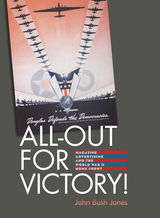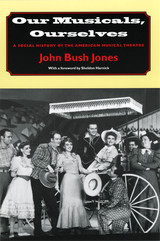2 books about Jones, John Bush

All-Out for Victory!
Magazine Advertising and the World War II Home Front
John Bush Jones
Brandeis University Press, 2009
Following the attack on Pearl Harbor and the entry of the United States into World War II, many commercial advertisers and their Madison Avenue ad agencies instantly switched from selling products and services to selling the home front on ways to support the war. Ads by major manufacturers showcased how their factories had turned to war production, demonstrating their participation in the war and helping people understand, for instance, that they couldn’t buy a new washing machine because the company was making munitions. Other ads helped civilians cope with wartime rationing and shortages by offering advice on how to make leftovers tasty, make shoes last, and keep a car in good working order. Ads also encouraged Victory Gardens, scrap collecting, giving blood, and (most important) buying War Bonds. In this book, Jones examines hundreds of ads from ten large-circulation news and general-interest magazines of the period. He discusses motivational war ads, ads about industrial and agricultural support of the war, ads directed at uplifting the morale of civilians and GIs, and ads promoting home front efficiency, conservation, and volunteerism. Jones also includes ads praising women in war work and the armed forces and ads aimed at recruiting more women. Taken together, war ads in national magazines did their part to create the most efficient home front possible in order to support the war effort.
[more]

Our Musicals, Ourselves
A Social History of the American Musical Theatre
John Bush Jones
Brandeis University Press, 2004
Our Musicals, Ourselves is the first full-scale social history of the American musical theater from the imported Gilbert and Sullivan comic operas of the late nineteenth century to such recent musicals as The Producers and Urinetown. While many aficionados of the Broadway musical associate it with wonderful, diversionary shows like The Music Man or My Fair Lady, John Bush Jones instead selects musicals for their social relevance and the extent to which they engage, directly or metaphorically, contemporary politics and culture. Organized chronologically, with some liberties taken to keep together similarly themed musicals, Jones examines dozens of Broadway shows from the beginning of the twentieth century to the present that demonstrate numerous links between what played on Broadway and what played on newspapers’ front pages across our nation. He reviews the productions, lyrics, staging, and casts from the lesser-known early musicals (the “gunboat” musicals of the Teddy Roosevelt era and the “Cinderella shows” and “leisure time musicals” of the 1920s) and continues his analysis with better-known shows including Showboat, Porgy and Bess, Oklahoma, South Pacific, West Side Story, Cabaret, Hair, Company, A Chorus Line, and many others. While most examinations of the American musical focus on specific shows or emphasize the development of the musical as an art form, Jones’s book uses musicals as a way of illuminating broader social and cultural themes of the times. With six appendixes detailing the long-running diversionary musicals and a foreword by Sheldon Harnick, the lyricist of Fiddler on the Roof, Jones’s comprehensive social history will appeal to both students and fans of Broadway.
[more]
READERS
Browse our collection.
PUBLISHERS
See BiblioVault's publisher services.
STUDENT SERVICES
Files for college accessibility offices.
UChicago Accessibility Resources
home | accessibility | search | about | contact us
BiblioVault ® 2001 - 2024
The University of Chicago Press









